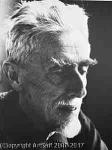Maurits Cornelis Escher
Maurits Cornelis Escher
Style: Op Art; Art Deco; Cubism; Expressionism; Op-Art; Realism; Surrealism; Renaissance;
Place: Leeuwarden
Born: 1898
Death: 1972
Biography:
Early Life and Inspiration
Maurits Cornelis Escher, a Dutch graphic artist, was born on June 17, 1898, in Leeuwarden, Friesland, Netherlands. He was the youngest son of civil engineer George Arnold Escher. Escher's early life was marked by his fascination with nature, which would later influence his artistic style.
Artistic Career
Escher's artistic journey began with studying decorative arts under Samuel Jessurun de Mesquita. In 1922, he traveled to Italy and Spain, sketching buildings, townscapes, and the intricate tilings of the Alhambra and the Mezquita of Cordoba. These experiences sparked his interest in the mathematics of tessellation, which became a powerful influence on his work.
Mathematical Inspirations
Escher's work features mathematical objects and operations, including impossible objects, explorations of infinity, reflection, symmetry, perspective, truncated and stellated polyhedra, hyperbolic geometry, and tessellations. Despite believing he had no mathematical ability, Escher interacted with notable mathematicians and conducted his own research into tessellation.
Notable Works and Legacy
- Circle Limit III, a woodcut showcasing his mastery of hyperbolic geometry.
- Relativity, a lithograph exploring the concept of relativity through a unique, mathematically inspired composition.
- Waterfall, a mezzotint demonstrating Escher's ability to create impossible objects and explore infinity.
Exhibitions and Recognition
Despite being somewhat neglected in the art world for long, Escher gained widespread appreciation in the twenty-first century. His work has been exhibited across the world, including at the Hague Museum, which holds a significant portion of his original prints and documentation.
- View Escher's works on Wikioo.org: Maurits Cornelis Escher | 246 Artworks
- Explore the math behind Escher's art: M. C. Escher - Wikipedia
- Discover more about Escher's inspirations and influences on Wikioo.org's blog: A Journey Through Art History with Wikioo.org’s Extensive Collection
Conclusion
Maurits Cornelis Escher, a Dutch graphic artist, left an indelible mark on the world of art and mathematics. His mathematically inspired woodcuts, lithographs, and mezzotints continue to fascinate audiences worldwide, cementing his legacy as a master of his craft.
Wikipedia link: Click Here














